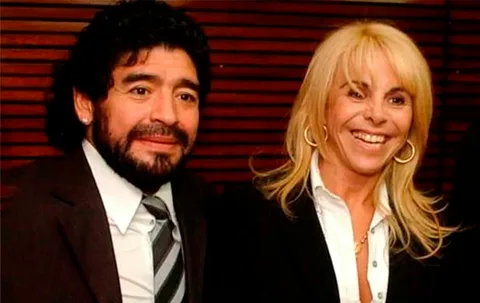
Who Is Diego Maradona
Diego Armando Maradona was an Argentine professional football player and manager who left an indelible mark on the world of soccer. Widely considered one of the greatest players in the history of the sport, he achieved legendary status through his extraordinary skills, charisma, and passion for the game. Maradona’s impact on the sport is immeasurable, and he was rightfully recognized with numerous accolades during and after his career.
Maradona was born on October 30, 1960, in Lanus, Argentina. He began playing football at a young age and quickly rose through the ranks, eventually joining the youth team of Argentinos Juniors. At just 16 years old, he made his professional debut for the club, showcasing his incredible dribbling ability, close ball control, and footballing intelligence. His performances on the pitch attracted attention, and in 1982, he moved to Barcelona, where he continued to mesmerize fans with his talent.
However, it was during the 1986 FIFA World Cup in Mexico that Maradona truly became a global sensation. His performances in that tournament are legendary. In the quarterfinal match against England, Maradona scored two of the most famous goals in football history. The first, known as the “Hand of God” goal, involved a clever and controversial handball, while the second, the “Goal of the Century,” showcased his incredible dribbling skills as he weaved past several English defenders to score. Argentina went on to win the World Cup, with Maradona leading the way as the tournament’s top scorer.
Maradona’s ability to dribble past multiple defenders with ease, his vision, and his creativity on the field were second to none. His playing style and skill set earned him the nickname “El Pibe de Oro” (The Golden Boy). He was known for his agility, balance, and the audacity to take on challenges that seemed impossible to overcome.
Throughout his career, Maradona played for several top clubs, including Napoli, where he achieved remarkable success by leading the club to Serie A titles and UEFA Cup victories. He became an icon in Naples, where he remains a beloved figure to this day.
Maradona’s career was not without controversy, as he faced personal and professional challenges, including issues with substance abuse. Despite these struggles, his footballing talent and charisma continued to captivate the world. He was named one of the joint winners of the FIFA Player of the 20th Century award, alongside Pelé, a testament to his lasting impact on the sport.
After retiring as a player, Maradona transitioned into coaching and management, guiding the Argentine national team and various clubs. He remained a prominent figure in the football world, and his name was synonymous with the sport itself.
Sadly, on November 25, 2020, Diego Maradona passed away, leaving behind a legacy that will forever be etched in the annals of football history. His influence on the game, his incredible skills, and his enduring impact on the hearts of fans around the world ensure that he will always be remembered as one of the greatest football players of all time.
Who Is Diego Maradona Wife
Claudia Villafañe is an Argentine personality known for her connection to the legendary footballer Diego Maradona. Born in Buenos Aires, Argentina, she is the daughter of Ana María Elía and Roque Nicolás Villafañe. Claudia Villafañe gained international recognition primarily for her long and notable marriage to Diego Maradona, which began when she was just 17 years old.
The story of Claudia Villafañe and Diego Maradona’s relationship began in Villa Fiorito, a neighborhood in Buenos Aires. They met at a young age and their romance blossomed into a long-lasting partnership. Their relationship endured its fair share of ups and downs, with moments of intense media scrutiny and public attention, given Maradona’s status as one of the most famous and controversial footballers in the world.
Despite the challenges and controversies that often surrounded Maradona’s life and career, Claudia Villafañe remained a significant presence in his life. She was not only his romantic partner but also his confidante and a stabilizing force during many tumultuous periods in his career. Their marriage produced two daughters, Dalma and Giannina.
Claudia Villafañe’s role in Maradona’s life extended beyond their personal relationship. She also played a key part in managing his financial affairs and helping to navigate various aspects of his career. Her influence on his life and career was significant, and she remained a supportive and grounding figure during Maradona’s meteoric rise and subsequent struggles.
Despite their tumultuous relationship, Claudia Villafañe and Diego Maradona shared a deep connection that lasted for many years. The complexities and dynamics of their partnership were often in the spotlight, reflecting the intersection of personal life and public scrutiny that comes with fame.
Diego Maradona and Claudia Villafañe’s story is a reflection of the complexities of fame, love, and relationships under the intense spotlight of the public eye. While their relationship had its share of challenges, it remained a significant part of both their lives and is a part of the broader narrative surrounding the legendary footballer’s legacy.
Why Diego Maradona Is Famous
Die Diego Maradona is widely celebrated for his extraordinary skills on the football field, which set him apart as one of the greatest players in the history of the sport. His dazzling style of play, characterized by incredible dribbling skills, speed, and precise ball control, made him a true maestro of the game. Maradona’s impact on football extended well beyond the pitch, and his career was also marked by a series of controversial off-field incidents.
On the field, Maradona’s dribbling abilities were nothing short of remarkable. He possessed an uncanny ability to maneuver past opponents with ease, often leaving defenders baffled and spectators in awe. His low center of gravity, agility, and close ball control allowed him to navigate through tight spaces and take on multiple defenders with grace and skill. Maradona’s dribbling prowess earned him the nickname “El Pibe de Oro” (The Golden Boy) and endeared him to fans around the world.
In addition to his dribbling skills, Maradona was known for his remarkable speed, which he used to burst past defenders and launch swift counterattacks. His acceleration and agility made him a constant threat in one-on-one situations, making it difficult for opposing teams to contain him.
Off the field, Maradona’s life was marked by controversies, including issues related to substance abuse and run-ins with the law. His personal struggles often garnered as much media attention as his footballing achievements. Despite these challenges, Maradona’s enduring popularity and status as a football icon remained intact, showcasing the deep impact of his talent and charisma.
Maradona’s time with Napoli in Italy is particularly noteworthy. During his seven-year stint with the club from 1984 to 1991, he achieved remarkable success, guiding Napoli to two Serie A titles in 1987 and 1990, as well as a UEFA Cup victory in 1989. His contributions to Napoli’s triumphs are still celebrated in the city, where he is regarded as a true legend.
In recognition of his significant contributions to Italian football and his unforgettable tenure with Napoli, Diego Maradona was inducted into the Italian Football Hall of Fame in 2005. This honor underscored his lasting impact on the sport and cemented his status as one of the most iconic figures in football history.
Diego Maradona’s legacy continues to live on in the hearts of football fans worldwide. His unique combination of skill, speed, and ball control, along with his undeniable charisma, ensures that he will forever be remembered as a footballing legend.
Diego Maradona Start In Football
Diego Maradona’s club career is a remarkable journey that began at a very young age and saw him achieve success with some of the most prominent football clubs in the world. His early foray into professional football and his rapid rise to stardom are legendary tales in the sport’s history.
Maradona made his professional debut for the Argentine club Argentinos Juniors on October 20, 1976, just a week before his 16th birthday. This debut at such a tender age was a testament to his prodigious talent and potential. He donned the number 16 shirt and was already making waves as a young football prodigy. Maradona’s incredible skills, including his dribbling ability, close ball control, and vision, were evident even at this early stage of his career.
Just a few weeks after celebrating his 16th birthday in November 1976, Maradona scored his first professional goal, further underlining his immense promise. His performances at Argentinos Juniors quickly drew the attention of football enthusiasts and scouts from around the world.
In 1981, Maradona made a significant move to Boca Juniors, one of Argentina’s most prestigious clubs. His transfer to Boca Juniors marked a pivotal moment in his career. In his first season with the club, he made an immediate impact by helping Boca Juniors clinch the league title in 1981. This triumph was a testament to his ability to inspire his team to success.
Maradona’s time with Boca Juniors solidified his reputation as one of the most talented players in Argentina and set the stage for his subsequent moves to top European clubs, including Barcelona and Napoli. His remarkable club career, which included numerous titles and accolades, established him as a footballing legend.
While his time at Boca Juniors was relatively brief compared to some of his other club stints, it served as an important chapter in Maradona’s journey. His success with the club helped pave the way for his transition to European football and the global recognition that would follow.
Diego Maradona’s club career was a testament to his extraordinary talent and impact on the world of football. His early debut and success at such a young age, along with his move to Boca Juniors, were early indicators of the greatness that would come to define his remarkable career in the sport.
Why Diego Maradona Is The Goat
Diego Maradona’s claim to being one of the greatest footballers of all time is supported not just by his statistics and accolades but also by the visual evidence of his extraordinary skills on the pitch. When you watch clips of Maradona playing, it becomes abundantly clear why many consider him a candidate for the title of the greatest of all time (GOAT).
One of the aspects that set Maradona apart from others was his ability to perform exceptionally well on various types of pitches, even under challenging conditions. The quote you provided alludes to the bumpy and uneven pitches he often encountered during his career. Despite these unfavorable conditions, Maradona showcased his unparalleled dribbling, close ball control, and agility, making it seem as if the ball was dancing to his tune.
Maradona’s extraordinary skill set allowed him to navigate through multiple defenders, taking the ball on mesmerizing journeys that left fans and opponents in sheer amazement. His low center of gravity, quick footwork, and the ability to change direction on a dime allowed him to excel on pitches that may have been less than perfect.
One of the most iconic displays of his skill on the pitch was the “Goal of the Century” during the 1986 World Cup quarterfinal match against England. Maradona dribbled past several defenders, showcasing his incredible control and balance, all while the ball seemed to adhere to his feet, regardless of the pitch conditions. The image of him gliding through the opposition remains etched in football history.
In addition to his dribbling abilities, Maradona’s vision, passing, and goal-scoring prowess were also exceptional. His ability to create opportunities for himself and his teammates on unpredictable and uneven pitches further solidified his status as a footballing genius.
Diego Maradona’s performances on the pitch speak volumes about his claim to being one of the greatest footballers of all time. Watching clips of him in action provides a vivid demonstration of his skills and why he continues to be celebrated as a true football legend. The bumpy pitches were just another canvas for Maradona to paint his masterpiece of footballing excellence.
Who Diego Maradona Son
Diego Armando Maradona Jr., born Diego Armando Sinagra on September 20, 1986, is an Argentine-Italian football coach, former player, and professional beach soccer player. He is best known for being the son of the legendary Argentine national footballer, Diego Maradona.
Diego Maradona Jr.’s story is marked by his unique parentage. He is the result of a relationship between Diego Maradona and Cristiana Sinagra, an Italian woman. This relationship was the source of considerable attention and controversy at the time, especially given Maradona’s fame and status as a global football icon. While his parentage may have initially raised questions and challenges, Diego Maradona Jr. has forged his own path in the world of football.
As a football coach and former player, Diego Maradona Jr. has demonstrated a passion for the sport. He has followed in his father’s footsteps by actively participating in the football world. Additionally, he has been involved in professional beach soccer, a sport that combines elements of traditional soccer with the unique challenges and dynamics of playing on the beach.
Diego Maradona Jr. has carried the weight of his famous name and family legacy, but he has also carved out his own identity in the realm of football. While his career may not have reached the same stratospheric heights as his father’s, he has undoubtedly made his own contributions to the sport.
Maradona Jr.’s journey is a testament to the complexities of life as the child of a sports legend. He has navigated the challenges and opportunities that come with his unique background and has found his own place within the world of football. His connection to the iconic Diego Maradona undoubtedly remains a significant part of his story, but he has also made his mark in his own right, contributing to the ongoing legacy of the Maradona name in the realm of sports.
Where Diego Maradona Died
Diego Maradona’s passing in 2020 was a moment of profound sadness for the world of football and for fans of the legendary player. Maradona, widely regarded as one of the greatest footballers of all time, died at the age of 60 due to a cardiac arrest.
Maradona’s health had been a concern for some time, and he had experienced various health issues over the years, including battles with substance abuse. His passing came as a shock to many, despite his prior health challenges.
In the aftermath of his death, there were investigations and legal proceedings surrounding the circumstances of his passing. Prosecutors raised questions about the medical care he received and whether there was any negligence or wrongdoing in his treatment. The investigation aimed to determine whether there were any factors that contributed to Maradona’s cardiac arrest.
The legal proceedings and investigations highlighted the intense interest and emotional impact of Maradona’s death, both in Argentina and around the world. He was not just a footballer but a cultural and sporting icon, and his passing was deeply felt by millions of fans.
The investigation into the exact causes of Maradona’s death continues to be a subject of scrutiny and debate, and it underscores the complexities that often surround the lives of iconic figures. Regardless of the circumstances, Diego Maradona’s legacy in the world of football remains indelible, and he is remembered for his extraordinary talent and the indomitable spirit he displayed throughout his life and career.
What Are Diego Maradona Achievement
Diego Maradona’s international career with the Argentina national team is a testament to his status as one of the greatest footballers in history. He earned 91 caps and scored 34 goals for his country, leaving an indelible mark on the international stage.
Maradona’s journey with the Argentina national team included four FIFA World Cup appearances. The pinnacle of his international career came in the 1986 World Cup held in Mexico. During this tournament, Maradona achieved legendary status by serving as the captain of the Argentine squad and leading them to victory over West Germany in the final. It was a tournament that showcased his exceptional talent, leadership, and footballing genius.
Maradona’s performances in the 1986 World Cup were nothing short of spectacular. He dominated the tournament with his incredible dribbling skills, precise passing, and scoring ability. In the quarterfinal match against England, he scored two of the most iconic goals in World Cup history – the “Hand of God” goal and the “Goal of the Century.” These moments symbolized his unique combination of audacity and talent.
Maradona’s extraordinary contributions during the 1986 World Cup earned him the Golden Ball, awarded to the tournament’s best player. This recognition was a testament to his unrivaled impact on the competition and his instrumental role in securing the World Cup title for Argentina.
Throughout his international career, Maradona’s ability to inspire his team and his remarkable skill set made him a beloved figure in his homeland and around the world. His performances for Argentina in the World Cup and other international competitions solidified his legacy as one of the sport’s all-time greats.
Diego Maradona’s international career stands as a symbol of his enduring impact on football. His leadership and extraordinary abilities on the pitch during the 1986 World Cup, in particular, are celebrated as one of the most remarkable chapters in the history of the sport. His achievements with the Argentina national team continue to inspire football enthusiasts and players to this day.
What was Diego Maradona Net Worth
Diego Maradona, despite his immense fame and accomplishments, had an estimated net worth of $500,000 at the time of his death. This figure is based on information provided by Celebrity Net Worth, a website that specializes in reporting on the wealth of famous individuals. The website’s net worth estimates are derived from a combination of financial analysis, market research, and inside sources.
Maradona’s relatively modest net worth at the time of his passing may come as a surprise to some, especially considering his status as one of the most iconic and influential footballers in history. However, there are several factors that contributed to this relatively lower net worth.
Maradona’s financial situation was complicated by various factors, including his well-documented battles with substance abuse, legal issues, and financial mismanagement over the years. Additionally, his lavish lifestyle and generosity towards family and friends may have also affected his financial stability.
While Maradona’s net worth may not have reflected his historical significance and his earnings during the peak of his career, his impact on the world of football and global popular culture cannot be understated. He was a true legend of the sport, and his contributions to football continue to be celebrated and remembered.
Despite his financial challenges, Diego Maradona’s legacy endures through his remarkable performances on the football field, his indomitable spirit, and his enduring influence on the sport and its fans around the world.
What Did Diego Maradona Retire
On October 29, 1997, Diego Maradona made a significant and emotional announcement that he was retiring from professional football. This announcement came from the balcony of his home in Buenos Aires, Argentina, and it sent shockwaves through the football world.
Maradona’s decision to retire at that time was marked by a mix of personal and professional challenges. He claimed that powerful individuals were attempting to frame him for drug use, which he believed was a ploy to force him to leave the game. The allegations and controversies surrounding his off-field behavior had followed him for a significant portion of his career, leading to suspensions and difficulties with various football authorities.
In making this announcement, Maradona expressed his desire to protect himself and his family from the growing pressures and legal battles that were looming. His retirement marked the end of a storied and often tumultuous career that had made him a global football icon.
While the circumstances surrounding his retirement were deeply personal and complex, Maradona’s departure from professional football left a void in the sport, as he had been one of the most celebrated and polarizing figures in the history of football. His contributions to the game, particularly with the Argentine national team and clubs like Napoli, had solidified his status as one of the greatest players of all time.
Diego Maradona’s retirement in 1997 was a turning point in his life and career. It marked the end of his journey as a professional player and the beginning of a new chapter in which he would continue to be a prominent figure in football, albeit in different capacities such as coaching and management. Regardless of the circumstances, his legacy as a footballing legend endures, and he remains a beloved and enduring figure in the world of sports.






